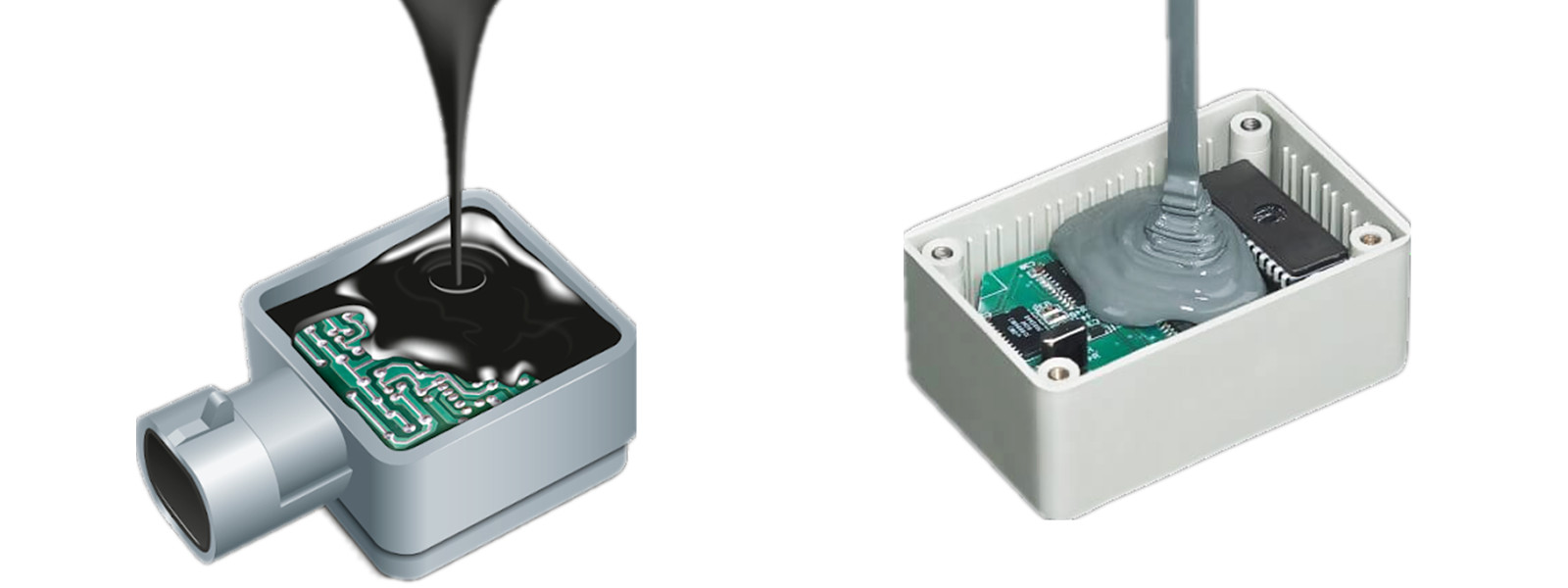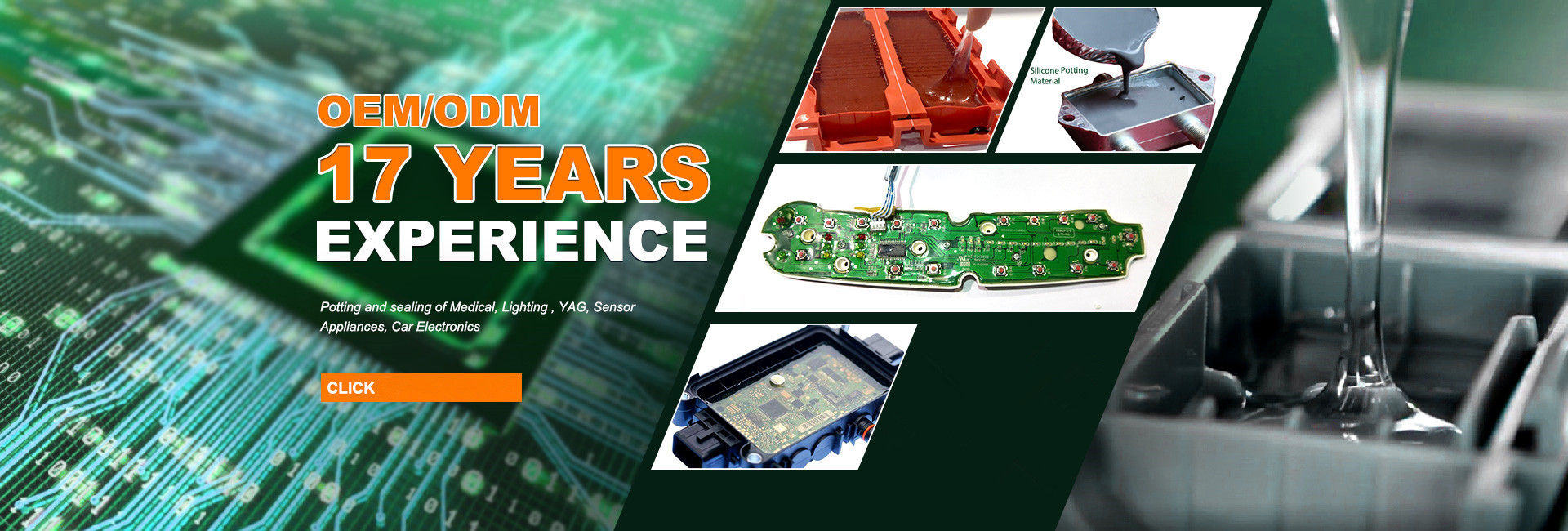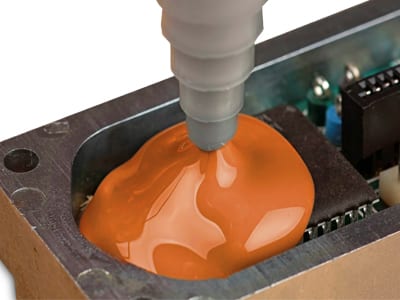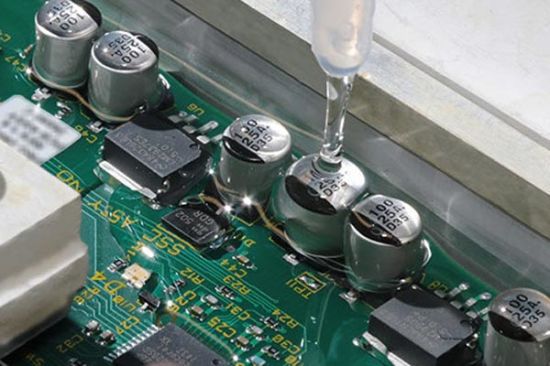
Begel 8078 Two components soft transparent silicone gel
Two component silicone elastomer that crosslinks at room temperature by polyaddition reaction.The pueolymerisation can be accelerated by heat ( max. 150℃ ).
Fast mixing ( 1:1) and easy processing due to the low viscosity.
Room curing at normal.
Very fast curing kinetics at elevated temperature.
Adhereand elastic surface
High tensile strength
Color: Clear
Packaging: Part A:10 KG, Part B:10 KG,
Application: The cured gel is used in some medical mattress, headrest, skin sticker, electric parts, IGBT module, junction box, auto control, and inverter.
USE:
Mixing the two components
Chagel 8078 A & B are mixed by weight in a fixed ratio given above.
The two components may be thoroughly mixed either by hand or using a low-speed electric or pneumatic mixer to minimise the introduction of air and to avoid any temperature increase.
Further information is available upon request.
Handling
The mixture should be degassed preferably at 30 to 50 mbar to eliminate any entrapped air. If a dispensing machine is used, the two components are degassed separately prior to mixing.
The silicone mixture expands to 3 to 4 times of its initial volume and bubbles rise to the surface .The bubbles progressively disappear and the mixture returns to its initial volume after 2 to 3 minutes. Wait a few minutes to complete the degassing and then flash the vacuum. The silicone is ready for pouring, either by gravity or under low pressure.
| Appearance | transparent |
| Penetration,1/mm | 90 |
| Dielectric Strength,KV/mm | 25 |
| Volume Resistivity,Ω·cm | 1.0×1015 |
| Dielectric Constant at 1 MHz | 2.8 |
| Range of Using temperature | – 60 ∽ 260 ℃ |
Chasil 1-0328 A/B 1:1 Soft Low Stress thermal conductivity Silicone Gel
Low Stress Encapsulant has a very low hardness and viscosity to minimize internal stress generation, fill small gaps, and improve manufacturing speed for complex and high volume electronic devices.
Soft, low durometer
Low viscosity
Room temperature or accelerated heat cure
Good thermal conductivity
Mix ratio 1 to 1
Low internal stress during thermal cycling
Highly flowable for filling small gaps and fast processing
Good heat dissipation
Prevents water ingress
Electrically insulative
Low total cost of ownership
Color: Black
Packaging: Part A:10 KG, Part B:10 KG,
Application:
Excellent flame resistance and protection against water ingress that improve the safety and reliability under harsh outdoor environments such as:
Power Conversion Devices (Inverters, Converters, Driver)
Junction Boxes
Automotive Electronics Modules
DESCRIPTION
Silicone encapsulants are supplied as two- part liquid component kits. When liquid components are thoroughly mixed, the mixture cures to a flexible elastomer, which is well suited for the protection of electrical/electronic applications.
Silicone encapsulants cure without exotherm at a constant rate regardless of sectional thickness or degree of confinement.
Silicone encapsulants require no post cure and can be placed in service immediately following the completion of the cure schedule.
Standard silicone encapsulants require a surface treatment with a primer in addition to good cleaning for adhesion while primerless silicone encapsulants require only good cleaning.
MIXING AND DE- AIRING
These products are supplied in a 1 to 1 mix ratio, which is very robust in manufacturing environments and allows for some process and dispense equipment variation. In most cases de-airing is not required.
| Property | Unit | Result |
| Color | ||
| Part A | Black | |
| Part B | Off-White | |
| Mixed | Dark Grey to Black | |
| Viscosity1 (Part A) | cps | 4500 |
| Viscosity2 (Part B ) | cps | 4500 |
| Mixed Viscosity3 | cps | 4500 |
| Specific Gravity4 (Part A) | 1.50 | |
| Specific Gravity5 (Part B) | 1.50 | |
| Working Time at 25°C (Pot Life) | minutes | 15±5 |
| Thermal Conductivity11 | W/mK | 0.60 |

Chagel 7078 A/B 1:1 Clear Two components soft silicone gel elastomer
A two component silicone elastomer that crosslinks at room temperature by polyaddition reaction. The pueolymerisation can be accelerated by heat.
Fast room temperature cure
Elastomer-like toughness
Protection from moisture, dirt, and other atmosphericcontaminants
Protection from mechanical stress and strain caused bythermomechanical shock and vibration
Easy repairability
Good dielectric properties, even at high frequencies
No solvents or cure by-products
Physical and electrical stability over a wide temperaturerange from -40° to 200°C
Color: Clear
Packaging: Part A:10 KG, Part B:10 KG,
Application: Used for semiconductor devices
Use:
Mixing the two components
A & B are mixed by weight in a fixed ratio given. The two components may be thoroughly mixed either by hand or using a low-speed electric or pneumatic mixer to minimise the introduction of air and to avoid any temperature increase.
Note: It is also possible to use a special mixing and dispensing machine for the two silicone components. Further information is available upon request.
Handling
The mixture should be degassed preferably at 30 to 50 mbar to eliminate any entrapped air. If a dispensing machine is used, the two components are degassed separately prior to mixing.
The silicone mixture expands to 3 to 4 times of its initial volume and bubbles rise to the surface .The bubbles progressively disappear and the mixture returns to its initial volume after 2 to 3 minutes. Wait a few minutes to complete the degassing and then flash the vacuum. The silicone is ready for pouring, either by gravity or under low pressure.
Note: Flashing the vacuum once or twice accelerates the degassing. It is recommended to use a container with a high diameter/height ratio(3 to 4 times of the initial volume)
Polymerisation
The system, as indicated in the technical data, polymerises at 25℃ .The curing may be slowed down at lower temperature and contrary accelerated by applying heatNote: in general contact with certain materials can inhibit the crosslinking of RTV.
See list below:
Natural rubbers vulcanised with sulphur
RTV elastomers catalysed with metal salts,e.g. tin compounds
PVC stabilised with tin salts and additives
Epoxy catalysed with amines
Certain organic solvents, e.g.Ketones, alcohols, ether etc.
| Appearance | transparent |
| Hardness, Shore A | 6-8 |
| Cone Penetration, ISO 2137 | 150g 35mm |
| Dielectric Strength,KV/mm | 25 |
| Volume Resistivity,Ω·cm | 1.0×1015 |
| Dielectric Constant at 1 MHz | 2.8 |
| Range of Using temperature | – 60 ∽ 200 ℃ |
Chasil 5218 A/B 10:1 condensation de-alcohol type low viscosity silicone potting material
A normally popular potting material. It supplies stable protection to variety of electric components. The mixture is flowable, would be deeply cured. The operation time can be adjusted according to the temperature and agent added. The majority of materials have a good bonding effect without primer, suitable for accessories fixed and waterproof, dust and leakage.
Two-component, condensation de-alcohol type
Low viscosity, easy processing
Low hardening shrinkage, no corrosion without stress
Excellent high temperature electrical insulation, stability set
Excellent adhesion, good waterproof, moisture resistance
Color: Clear, White
Application: Automotive electronics, modules, Power control module, Solar module junction box, LED spotlights, wall washer, bar lights, LED lamps
Use:
A, B components according to the ratio of 100: 10 weighing, mixing evenly, directly into the pot to protect the components (or modules). It is best to slowly follow the side of the wall, can reduce the generation of bubbles.
the potting of the components put away, let its own bubble, conditional customers can be in the potting before the vacuum mixture of vacuum degassing treatment. Directly at room temperature curing, usually within 1-6hr to achieve elasticity of the adhesive layer.
need to quantitative irrigation potting equipment, please consult my company marketing department.
PACKAGING
Part A: 20kg/plastic pail; Part B: 5kg/plastic pot.
SHELF LIFE AND STORAGE
B components to be protected from light, heat, sealed (can be transported as non-dangerous goods and preservation);
For each part, the shelf life is 1 year (at 25°C)
| Item | Method | 5218T-A | 5218M-A |
| Appreance | Visual | colorless transparent,fluid | Matte white fluid |
| Viscosity,cps, 25℃ | GB/T 2794-2013 | 1300 | 1800 |
| Density,g/cm3, 25℃ | GB/T 15223-1994 | 1.02 | 1.03 |
| Curing agent | with part B | 5218T-B | 5218T-B |
| Mix Ratio | A:B = 100:(10±3) | ||
| Viscosity after mixing, cps , 25℃ | GB/T 10247-2008 | 1,000 | 1,000 |
| Appreance | Visual inspection | colorless transparent, elastomer | Matte white elastomer |
| Hardness, SHORE A | GB/T 531-2008 | 21 | 21 |

Chasil 0328 A/B 1:1 low VISCOSITY high Performance & Thermal Conductivity Flame retardant silicone material
Flame retardant
Two-part, 1:1 mixingratio
Medium viscosity Room temperature cure or rapid heat cure
Addition cure system: no cureby-products
Flame retardant
Stable and flexible from -50°C(58°F) to +250°C (432°F)
Flexible rubber – protects against mechanical shock and thermal cycling stress at components
Excellent dielectricproperties
Color: Gray, Black
Packaging: Part A:25 KG, Part B:25 KG,
Application:
Designed to protect against moisture, environmental attack, mechanical and thermal shock as well as vibration especially where good adhesion is
Typical applications include: encapsulation of amplifiers, automotive electronic units, ballast, bleed resistors, connectors, flyback transformers, high voltage resistor packs, lifting magnets, power controllers, power supplies, radio frequency induction transformers and sensing
Use:
Substrate preparation
All surfaces should be cleaned and degreased with a suitable solvent prior to potting. Care should be taken to ensure that all solvent is removed. For best adhesion, coat surfaces with BGX-706, following the instructions and precautions given for use of these products.
Mixing
CHASIL 0328 is supplied in lot matched kits consisting of Part A and Part B in separate containers. During long periods of storage, someof the filler may settle at the bottom of the containers and should be individually homogenised prior to
Apply
The two components should be thoroughly mixed using a weight ratio of 1:1 until the mixture has a uniform colour. Vacuumde-airing is recommended. A residual pressure of 10-20 mm mercury applied for 5-10 minutes will sufficiently de-air the
Being careful to avoid air entrapment, apply the encapsulant. Vacuum encapsulation is recommended for complex geometries. For information on appropriate dispensing equipment for your application, please contact Beginor marketing department.
Curing
CHASIL 0328 should be cured using one of the following recommended schedules:
8 hours at 23°C, or 60 minutes at 70°C, or 30 minutes at 100°C, or 15 minutes at 150°C. Large components and assemblies may require longer times in order to reach the curing temperature
Property | GB/T | ASTM | Unit | Value A/B |
Colour (Part A/Part B) | Black /white | |||
Viscosity at 23°C (Part A/Part B)¹ | 10247-2008 | D1084 | mPa.s | 3000±1000/3000±1000 |
Specific gravity at 23°C (Part A/Part B) | 13354-92 | D792 | g/cm3 | 1.52/1.52 |
Physical properties, cured 30 minutes at 150°C | ||||
Colour | White or Black or Gray | |||
Specific gravity at 23°C | 13354-92 | D792 | g/cm3 | 1.52 |
Thermal conductivity | 10297-1998 | D2214 | W/(m.K) | 0.8 |
Chasil 0528 high purity two component liquid silicone material for optical device modules
A high purity two-component heat curing silicone materials. Resistance to environmental pollution, moisture, shock, vibration, etc., Maintain optical properties, mechanical properties and electrical properties in a wide range of temperature, humidity and harsh environmental conditions
High transparency
Excellent heat resistance
Long-term resistancetoUV-A and UV-B
No yellowing
Fast curing and rapid demold
Extremely accurate molding effect
Lighter than glass
Color: Clear
Packaging: Part A:10 KG, Part B:10 KG,
Application: Designed for the manufacture of optical device modules, and can be used for injection molding an optical lens and an optical wave guide coupling reduces scattering loss.
USE:
The substrate surface should be clean and dry. The substrate can be heated to remove surface moisture. Using naphtha, methyl ethyl ketoxime (MEK) or other suitable solvent to clean surface of the substrate. It should not use the solvent which dissolve or corrode to the substrate, should not use residual solvent.
Please keep accurate weigh to a clean glass container and mix thoroughly. When using high speed mixing equipment, heat will generate and the work time will reduce.
Under 10mmHg vacuum extrusion bubble. Usually prolapse bubbles before dispensing packaging material.
In most cases, the polysiloxane is suitable for working long hours at -45°Cto 200°C, the maximum short-term resistant to 350°C, the specific use, it is best to test the actual requirements.
Before the uncured material, containing not touch N \ P \ S and other organic matter, cannottouch Sn \ Pb \ Hg \ Bi \ As the ionic compound, etc., cannottouch the acetylene-containing \ active vinyl compound, peroxide cannot touch not touch the water gas and alcohols. These substances will hinder curing material reaches a certain concentration, the specific performance of three phenomena: the flow has been in a state completely cured, and the substrate base surface with thin fluid or in Las state, the contact surface and the substrate smiling bubbles. Fully test before use.
Should be cured by heating using a hot air oven ventilation to prevent the accumulation of trace amounts of hydrogen generated in the curing process to produce an explosion hazard.
Properties before curing | ||||
Property | Standard/Units | Chasil 0528 A | Chasil 0528 B | |
Ingredient | —- | Polysiloxane | Hydrogen polysiloxane | |
Appearance | Visual inspection | Colorless liquid | Colorless liquid | |
Viscosity | mPa·s (25°C) | 4000-6000 | 4000-6000 | |
Density | g/cm3 (25°C) | 0.99 | 0.99 | |
Mixing ratio | Mass ratio | A:B=100:100 | ||
Properties after curing | ||||
Hardness | shore A | 50 | ||
Tensile strength | MPa | 5.5 | ||
Light Transmission | 450nm@1mm,% | > 90 | ||
Volume resistance | ohm.cm | 2×1015 | ||







